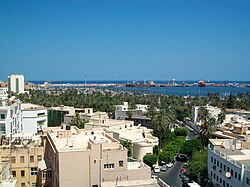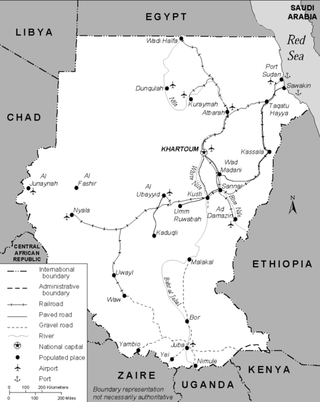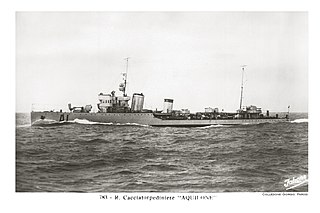
The Port of Tripoli is the principal sea port in Tripoli, the capital of Libya, and one of the oldest ports in the Mediterranean. The port serves general cargo, bulk cargo & passengers.

The Port of Tripoli is the principal sea port in Tripoli, the capital of Libya, and one of the oldest ports in the Mediterranean. The port serves general cargo, bulk cargo & passengers.
In 1911, Italy claimed the need to protect its citizens who lived in the Port of Tripoli. It declared war against the Ottomans, saying it would annex the city. A naval battle fought at Prevesa, Greece, ended in the destruction of three Ottoman ships and the recognition of Italian sovereignty over the Port of Tripoli. The Italians controlled the region until 1943. British forces governed the area after World War II until Libyan independence in 1951 World Ports History: Tripoli [1]
Since Roman Libya the port of Tripoli (then called Oea) was one of the main in coastal Mediterranean Africa. In the Middle Ages the port fell into disuse, but under Ottoman rule started to grow in importance. In the late 1920s, the Italian colonial authorities created the port that exists today. Other important infrastructures added in the 1930s were the enlargement of the port of Tripoli with the addition of a seaplane facility. [2] The port was severely damaged during WWII.

In the 1970s the port was greatly improved: now the port of Tripoli contains many cargo terminals, and is capable of servicing many ships at once. The port also features a yacht club, and a fishing wharf.
Libya has had a long history of port congestion. In 1977 the average waiting time for ships to be unloaded in Tripoli harbor was 24 days. Consequently, since the mid-1970s, port improvements have been a top priority for the government. These improvements raised Libya's total dry cargo handling capacity from 10.5 million tons in 1976 to 13.7 million tons in 1980. In 1985 major cargo-handling ports were located at Tripoli, Benghazi, Tobruk, and Qasr Ahmad (near Misratah). Projects underway at Tripoli in 1985 were designed to raise the port's handling capacity to 12.5 million tons a year. Library of Congress Country study: Libya
The "Socialist Ports Company" is the port authority responsible for managing and operating the Port of Tripoli, which handled general and bulk cargoes and passengers.
Protected by two breakwaters of 2000 and 700 meters, the harbor covers about 300 hectares. About 600 huge vessels visited the Port of Tripoli each year until the end of Gaddafi regime. The port can accommodate vessels up to 190 meters long with a maximum draft of 10.7 meters.

Transport in Sudan during the early 1990s included an extensive railroad system that served the more important populated areas except in the far south, a meager road network, a natural inland waterway—the Nile River and its tributaries—and a national airline that provided both international and domestic service. Complementing this infrastructure was Port Sudan, a major deep-water port on the Red Sea, and a small but modern national merchant marine. Additionally, a pipeline transporting petroleum products extended from the port to Khartoum.

Benghazi is the second-most-populous city in Libya as well as the largest city in Cyrenaica, with an estimated population of 859,000 in 2023. Located on the Gulf of Sidra in the Mediterranean, Benghazi is also a major seaport.

A cargo ship or freighter is a merchant ship that carries cargo, goods, and materials from one port to another. Thousands of cargo carriers ply the world's seas and oceans each year, handling the bulk of international trade. Cargo ships are usually specially designed for the task, often being equipped with cranes and other mechanisms to load and unload, and come in all sizes. Today, they are almost always built of welded steel, and with some exceptions generally have a life expectancy of 25 to 30 years before being scrapped.

A merchant ship, merchant vessel, trading vessel, or merchantman is a watercraft that transports cargo or carries passengers for hire. This is in contrast to pleasure craft, which are used for personal recreation, and naval ships, which are used for military purposes.

The Port of Karachi is one of South Asia's largest and busiest deep-water seaports, handling about 60% of the nation's cargo located in Karachi, Pakistan. It is located on the Karachi Harbour, between Kiamari Azra Langri, Manora, and Kakapir, and close to Karachi's main business district and several industrial areas. The geographic position of the port places it in close proximity to major shipping routes such as the Strait of Hormuz. It is also ideally located to offer gateway services to the maritime trade for the Central Asian Republics (CARs). The administration of the port is carried out by the Karachi Port Trust, which was established in 1857.

The Syama Prasad Mookerjee Port, formerly the Kolkata Port, is the only riverine major port in India, in the city of Kolkata, West Bengal, around 203 kilometres (126 mi) from the sea. It is the oldest operating port in India and was constructed by the British East India Company. Kolkata is a freshwater port with no variation in salinity. The port has two distinct dock systems – Kidderpore Dry Dock at Kolkata and a Deep Water Dock at Haldia Dock Complex, Haldia.

The Port of Ashdod is one of Israel's three main cargo ports. The port is located in Ashdod, about 40 kilometers south of Tel Aviv, adjoining the mouth of the Lachish River. Its establishment significantly enhanced the country's port capacity. It handles the largest volume of cargo containers annually of all Israeli ports. Ships carrying humanitarian aid for the Gaza Strip also unload their cargo at Ashdod.

The Port of Haifa is the largest of Israel's three major international seaports, the others being the Port of Ashdod, and the Port of Eilat. Its natural deep-water harbor operates all year long and serves both passenger and merchant ships. It is one of the largest ports in the eastern Mediterranean in terms of freight volume and handles about 30 million tons of cargo per year. The port employs over 1,000 people, rising to 5,000 when cruise ships dock in Haifa. The Port of Haifa lies north of Haifa's downtown quarter on the Mediterranean and stretches to some three kilometres along the city's central shore with activities ranging from military, industrial, and commercial next to a nowadays-smaller passenger cruising facility.

The Port of Xiamen or Port of Amoy or Amoy Port is an important deep water port located on Xiamen Island, the adjacent mainland coast, and along the estuary of the Jiulong River in southern Fujian, China. It is one of the trunk line ports in the Asia-Pacific region. It is ranked the 8th-largest container port in China and ranks 17th in the world. It is the 4th port in China with the capacity to handle 6th-generation large container vessels. In 2013, Xiamen handled 191 million tons of cargo, including 8.08 million TEUs of containers. On 31 August 2010, Xiamen Port incorporated the neighboring port of Zhangzhou to form the largest port of China's Southeast. This was a relatively uncommon case of ports merging across jurisdictions.

V. O. Chidambaranar Port is a port in Thoothukudi, Tamil Nadu, and is one of the 12 major ports in India. It was declared to be a major port on 11 July 1974. It is the second largest port in Tamil Nadu and third largest container terminal in India. V.O. Chidambaranar Port is an artificial port. This is the third international port in Tamil Nadu and it is second all-weather port. All V.O. Chidambaranar Port Authority's traffic handling has crossed 10 million tons from 1 April to 13 September 2008, registering a growth rate of 12.08 per cent, surpassing the corresponding previous year handling of 8.96 million tons. It has services to USA, China, Europe, Sri Lanka and Mediterranean countries. The Station Commander, Coast Guard Station Thoothukudi is located at V.O. Chidambaranar Port Authority, Tamil Nadu under the operational and administrative control of the Commander, Coast Guard Region (East), Chennai. The Coast Guard Station V.O. Chidambaranar Port Authority was commissioned on 25 April 1991 by Vice Admiral SW Lakhar, NM, VSM the then Director General Coast Guard. The Station Commander is responsible for Coast Guard operations in this area of jurisdiction in Gulf of Mannar. V.O. Chidambaranar Port Authority Thoothukudi is an ISO 9001:2008, ISO 14001:2004 and International Ship and Port Facility Security (ISPS) Code compliant port.

Lekki Deep Sea Port, is a multi-purpose, deep sea port in the Lagos Free Zone and is the only currently operating deep sea port in the country, having started full commercial operations in April 2023.
The Port of Benghazi is a major seaport in the city of Benghazi, Libya, on the Mediterranean Sea coast within the Gulf of Sidra.

The Port of Tobruk is a port located at Tobruk, Libya. Opened in 1986, it is located in Eastern Libya near the Egyptian border - about 450 km (280 mi) east of Benghazi. The entrance to the main channel into the port is between Tobruk point and the point of Marsa Ummash Shawush.

Mundra Port is India's first private port, largest container port and largest commercial port, located on the northern shores of the Gulf of Kutch near Mundra, Kutch district, Gujarat. Formerly operated by Mundra Port and Special Economic Zone Limited (MPSEZ) owned by Adani Group, it was later expanded into Adani Ports & SEZ Limited (APSEZ) managing several ports. In FY 2020–21, Mundra Port handled 144.4 million tonnes of cargo. The port currently handles over 155 MT, which constitutes nearly 11 per cent of India’s maritime cargo. The port also handles nearly 33 per cent of India’s container traffic.

Marsa Maroc is the main operator of ports in Morocco. Its legal status is a Société Anonyme (Plc.) with an Executive board chaired by Mohammed Abdeljalil and a supervisory board chaired by the Minister of Equipment and Transport. The official company name is Société d'Exploitation des Ports while Marsa Maroc is its trading name.

The Haldia Dock Complex (HDC) is a docking facility on the Hooghly River in Haldia, West Bengal, India. It is one of the two dock systems under the Syama Prasad Mookerjee Port, Kolkata, with the other being the Kolkata Dock System (KDS). The facility specializes in handling dry and liquid bulk cargo. It is located about 130 kilometres (81 mi) from the sandheads–deep sea area of the Bay of Bengal, 45 kilometres (28 mi) upstream from Pilotage Station at Sagar and 104 km downstream of Kolkata. In 1968, an oil jetty was commissioned at Haldia, and officially in 1977 the dock facility of Haldia started functioning.

Borea was one of eight Turbine-class destroyers built for the Regia Marina during the late 1920s. She was named after a northerly wind, Borea, bringing frigid, dry air to the Italian peninsula. The ship played a minor role in the Spanish Civil War of 1936–1937, supporting the Nationalists.

Turbine was the lead ship of her class of eight destroyers built for the Regia Marina during the 1920s. Her name means whirlwind.

Aquilone was one of eight Turbine-class destroyers built for the Regia Marina during the late 1920s. She was named after Aquilone, a cold northerly wind.
Barletta was an Italian cargo liner built during the 1930s and later became an auxiliary cruiser of the Regia Marina during World War II.
32°54′17″N13°11′36″E / 32.90472°N 13.19333°E